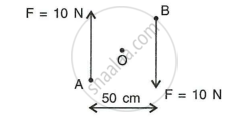Advertisements
Advertisements
प्रश्न
An effort is applied on the bigger wheel of a gear having 32 teeth. It is used to turn a wheel of 8 teeth. Where it is used.
उत्तर
The number of teeth in the driving wheel is nB = 32 and that in the driven wheel is nA = 8. Hence, this system is used to obtain the gain in speed
The Gain in speed = `n_B/n_A`= `32/8 = 4`
APPEARS IN
संबंधित प्रश्न
What do you mean by the clockwise and anti-clockwise moment of force?
Find the moment of force of 20 N about an axis of rotation at distance 0.5 m from the force.
What are non-contact forces? Give two example
A car of mass 600 kg is moving with a speed of 10 m-1 while a scooter of mass 80 kg is moving with speed of 50 m s-1. which vehicle will require more force to stop it in the (1) same interval of time (2) same distance
A nut is opened by a wrench of length 10 cm. if the least force required is 5.0 N. find the moment of force needed to turn the nut.
The diagram shows two forces F1 = 5 N and F2 = 3N acting at point A and B of a rod pivoted at a point O, such that OA = 2m and OB = 4m

Calculate:
- Moment of force F1 about O
- Moment of force F2 about O
- Total moment of the two forces about O.
The figure shows two forces each of magnitude 10 N acting at the point A and B at a separation of 50 cm, in opposite directions. Calculate the resultant moment of two forces about the point.
- A,
- B and
- O situated exactly at the middle of the two forces.

Fig. shows a uniform meter scale weighing 100 N pivoted at its centre. Two weights of 500 N and 300 N are hung from the ruler as shown in fig.

(i) Calculate total clockwise and anticlockwise moments.
(ii) Calculate difference in clockwise moment and anticlockwise moment.
(iii) Calculate the distance from O where a 100 N weight should be suspended to balance the meter scale.
The diagram shows a uniform metre rule weighing 100gf, pivoted at its centre O. Two weights 150gf and 250gf hang from the point A and B respectively of the metre rule such that OA = 40 cm and OB = 20 cm. Calculate :
the total clockwise moment about O

State one factor on which the magnitude of a non-contact force depends. How does the magnitude of a non-contact force change along with distance?
